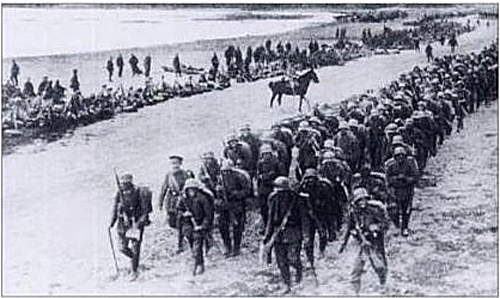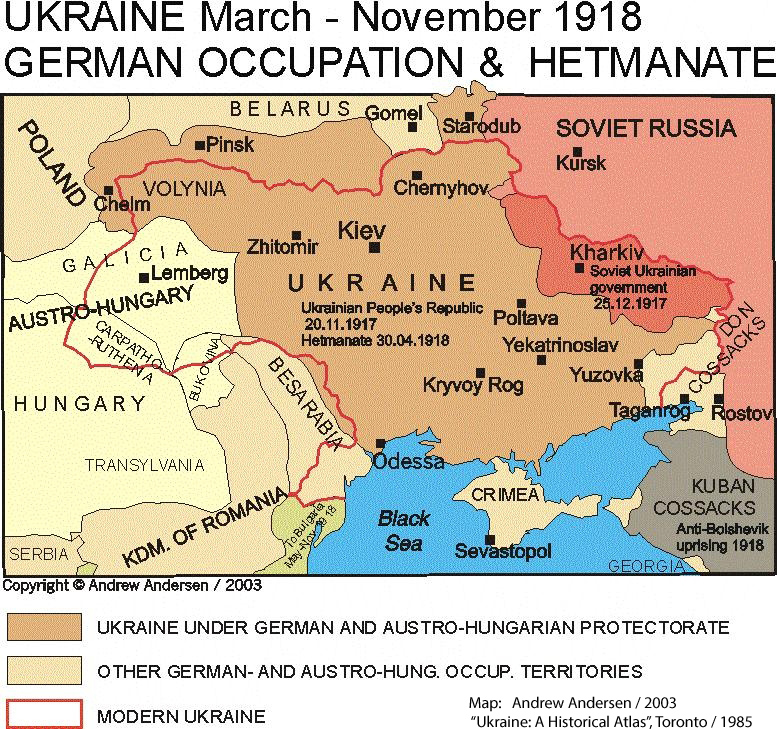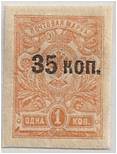ALBUM – view my Crimea, German Occupation Album
TRANSITION CHART – Ukraine and South Russia
Fast Facts
Region: Russia Area
Group: Ukraine and South Russia
Classification: Puppet Government (Germany)
Prior Regime: Russian Empire
Key Dates:
1917, Sept – Bolshevik Government led by Vladimir Lenin established
1918, Apr/May – German offensive took control of Crimea
1918, Jun 25 – Germans establish Crimean Government led by Gen. Maciej Sulkevich
1918, Nov – Germans withdraw from Crimea, Sulkevich government falls
1918, Nov – Crimean Border Government established under Solomon Krym
1919, Apr – Allies withdraw from Crimea, Red Army takes over
1919, Jun – White Army under General Denikin drives out Red Army
1920, Nov – Wrangel evacuates the White Army in Crimea and the Bolsheviks take control
Following Regime:Crimean Regional Government under Solomon Krym
Scott Catalogue: (South Russia) #51
Pick Catalogue: (Ukraine and Crimea) #S364-S368
History

Finally, in March of 1917, the people, fed up with the massive casualties caused by the war, and chronic food shortages within the nation, revolted and forced Tsar Nicholas to abdicate the throne. A provisional government was formed based on democratic principles, but was overthrown a few months later in Sept of 1917 by the Bolshevik movement (the Red Army), led by Vladimir Lenin. This new, government (which became the Russian Soviet Federative Socialist Republic) began a long and bloody campaign to unite the former Russian Empire under the communist banner. Chaos broke out across the country, and in July 1918 the Bolsheviks had the royal family killed to avoid having them serve as a focal point for the anti-Bolshevik movement (the White Army).
 Crimea is a large peninsula which sits out in the Black Sea has been for centuries the home of the Crimean Tartars, and was part of the Russian Empire since 1783. By the time of the 1917 Revolution, Crimea was made up of a mixed population including Tartars, Moslems and Kariate Jews. After the October Revolution, the local Tartars proclaimed an independent “Crimean People’s Republic”, but within a few months, it was crushed by the Bolsheviks. Taking advantage of the turmoil in Russia, German forces in the Ukraine took Crimea in Apr/May 1918, and on 25 Jun, 1918 established a Crimean puppet government lead by General Maciej Sulkevich, a Lithuanian Muslim.
Crimea is a large peninsula which sits out in the Black Sea has been for centuries the home of the Crimean Tartars, and was part of the Russian Empire since 1783. By the time of the 1917 Revolution, Crimea was made up of a mixed population including Tartars, Moslems and Kariate Jews. After the October Revolution, the local Tartars proclaimed an independent “Crimean People’s Republic”, but within a few months, it was crushed by the Bolsheviks. Taking advantage of the turmoil in Russia, German forces in the Ukraine took Crimea in Apr/May 1918, and on 25 Jun, 1918 established a Crimean puppet government lead by General Maciej Sulkevich, a Lithuanian Muslim.
Sulkevich and the Crimeans soon realized that under the “protectorate” status, they had very limited in control. As in Ukraine, the Germans enacted very harsh measures on the peasants to produce grain to ship back to a war torn Germany. Originally Ukrainian grain shipments were to be transferred back by land, but the advancing Bolshevik army made such shipments risky, therefore Crimea was essential for creating a port for shipping the grain by water.
As the outcome of the war became obvious, Sulkevich approached General Anton Denikin, commander of the large anti-Bolshevik White Army, but Denikin wanted nothing to do with Sulkevich, who had fought on the side of the Germans during the war. After the defeat of Germany in World War 1, German forces withdrew from Crimea in November of 1918, and the unpopular pro-German government of General Sulkevich was quickly disposed.
An anti-Bolshevik government, called the Crimean Border Government was established on 16 Nov, 1918 led by Solomon Krym, Kariate Jew and a former member of the state senate, and had opposed Sulkevich during the occupation. At the defeat of the Germans and Ottomans in the war, Allied forces sailed into the Black Sea taking various strategic ports. The French Navy captured Odessa in south Ukraine, and landed in Sevastopol along with other Crimean ports. Due to the ongoing fighting in Russia, the French withdrew from Sevastopol on 15 Apr 1919, and signed an armistice with the Bolsheviks 3 days later on the 18th. The Red Army took over Crimea within a matter of days and the Crimean Regional Government collapsed. Solomon Krym and his officials evacuated Crimea to France.
The Red Army victory was short lived as in June 1919, Denikin’s White Army swept into Crimea and forcing Bolshevik forces to flee. General Denikin commanded the large White Army which controlled most of the territory in Southern Russia. The Whites continued to push its troops north towards Moscow until they were decisively defeated in Orel in October, 1919. From this point forward, Denikin’s Army slowly retreated south, ultimately consolidating in Crimea. On 20 Mar 1920, Denikin was forced to resign and leadership passed on to Pyotr Nikolayevich Wrangel. While General Wrangle attempted to create a stronghold in Crimea and North Tavria while trying to establish a coalition with other Anti-Bolshevik republics, in reality it was too late as the strength and momentum of the Red Army was too great. After several major losses and continued retreat, Wrangle organized a mass evacuation from Crimea in Nov 1920 rather than leave his men to the wraith of the advancing Communists.
Stamps
 ALBUM
ALBUM
In October, 1918, due to changes in postage rates, the Sulkevich government needed to issue 35 kopeck stamps for ordinary postage. Stocks of existing Russian 1 kop imperforate stamps, useless do the high inflation in Russia, were overprinted in black letters “35 KOP” in black by typography. A large quantity of these stamps were overprinted, and are still quite easily obtained by collectors.
These stamps continued to be used well into 1919.
For other Crimean Stamps see the Crimean Border Government (1918-19) and Crimea under White Army Control (1919-20).
Banknotes
Three obligation notes were issued the Occupation period in the denominations of 500, 1000 and 5000 rubles.
Links
SOVIET-UKRAINIAN WAR (1917 – 1921) by Arkadiy Zhukovsky
History of Crimea – Wikipedia
German Army in the East – 1918
Banknotes of Ukraine and Crimea from AST notes




